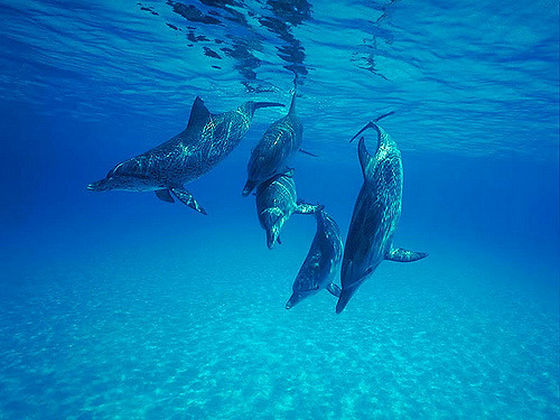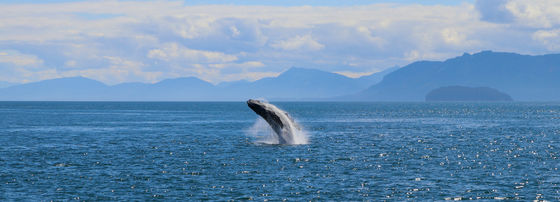How to sleep whales and dolphins without drowning?

ByJennifer C.
Marine mammals such as whales and dolphins who live their lives forever in the sea are mammals although they are living in the water, so you can not breathe in the water, you need to breathe out on the water surface. Some marine mammals can continue to diving for nearly an hour without breathing, but still there is a need to sleep, "How do you sleep without getting drowning?" The question raises up. About such marine mammalian sleep,Scientific AmericanIt is summarized.
How do Whales and Dolphins Sleep Without Drowning? - Scientific American
https://www.scientificamerican.com/article/how-do-whales-and-dolphin/

Observation of handwort dolphins in aquariums and zoos and observation of wild whales and dolphins seems that marine mammalian sleeping methods can be roughly divided into two when divided roughly. One is to "rest vertically or horizontally in water and rest" and the other is "to sleep slowly while swimming on the side of another animal". The dolphin mainly goes into a deeper sleeping form at night, but this state dolphin looks like a log floating on the water surface, so it is called "logging".

ByJennifer C.
Simultaneous actions of marine mammals asleep or swim are close to the state of "nap" as people say. Children of whales and dolphins may not be able to float well for several weeks after birth, for example because "the amount of fat is not enough." Then, how about whales and dolphins children are swimming is said to be behind the mother's swimmingSlipstreamIt seems to swim to use. In other words, children's whales and dolphins follow their mothers and are eating and sleeping. Of course, during that time, the mother can not stop swimming, so take a meal or sleep while swimming.
If you swim too much, young marine mammals will weaken. Therefore, adult 's male dolphin usually seems to swim in pairs, swim slowly side by side when sleeping. On the other hand, in the case of female or young dolphins, it is likely that they will take a break in the same area while moving in a group and pair with dolphins to sleep while swimming.
When sleeping, the hand dolphin makes half of the brain sleep, but the other one is at a low level of arousal. This is done to protect yourself from predators and obstacles and to determine when you need to float to the surface of the water for breathing. This half sleeping state will be switched in about 2 hours, and if the right brain was asleep first, the left brain will sleep after 2 hours. This way of sleeping is called "hemisphere sleep", it seems that it can be seen in some animals such as migratory birds as well as marine mammals such as dolphins and whales.

ByJay Ebberly
Dolphins generally sleep at night, but only sleep for several hours at a time. This is because dolphins feed fish and squid which occur at midnight as food. However, according to EEG of hand-dolphins, it seems that they are sleeping as much as 33.4% on average on average. Whether or not a whale dreams are not certain, although it is only 6 minutes a nightREM sleepThere is also a report that it was confirmed.
In order to avoid drowning while sleeping, it is important for marine mammals to control "fumaroles (squirt holes)" used for breathing and vocalization. It is thought that this fumaroles are opened and closed under the voluntary control of animals. While sleeping, human beings can breathe even under unconsciousness, whales and dolphins have a spontaneous respiratory system, so you can not breathe unless you are conscious. Although there is room for discussion, many scientists speculate that dolphins and whales are conscious during sleep due to breathing.
In addition, marine mammals have the property that they can hold their breath longer than other mammals. This is because marine mammalian lungs are larger than those of other animals, so it is possible to capture more air with a single breath. Also, because you can exchange a lot of air with a single breath, you can carry more oxygen into your body. And, marine mammal blood that diving is only able to carry to 'body part requiring oxygen at the time of diving' called muscle used for heart, brain and swimming, so do not breathe frequently It can also swim efficiently.

ByNavin 75
In addition, marine mammals are more resistant to carbon dioxide. The brains of whales and dolphins seem to be much higher in carbon dioxide level than what human beings can tolerate. This mechanism is part of the marine mammalian diving response and can be said to be the result of adaptation in living in the water. This is especially useful during sleeping, and whales and dolphins both reduce breath during sleep.
From these mechanisms, it is very rare for marine organisms to drown in the water, but instead they suffocate from the air shortage in the water. "Breathing for the first time" is very important for newly born dolphins and whales, and it is said that children who have never sucked in air are often found when dissecting dead bodies. Also, even if marine mammals hit the fishing net, it seems there are cases where it is impossible to go out to the surface and suffocation is killed.
Related Posts:







